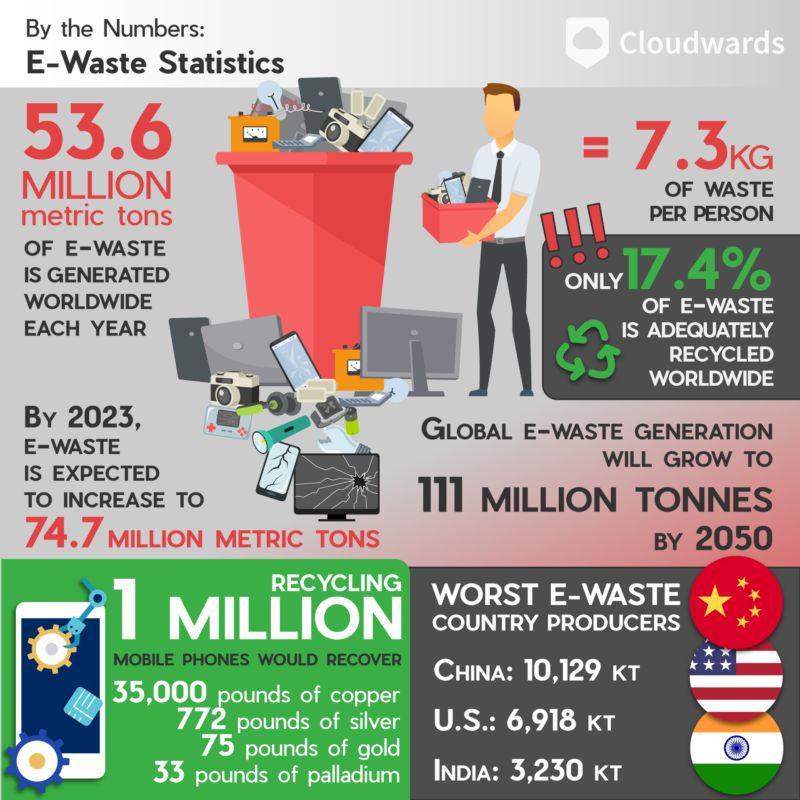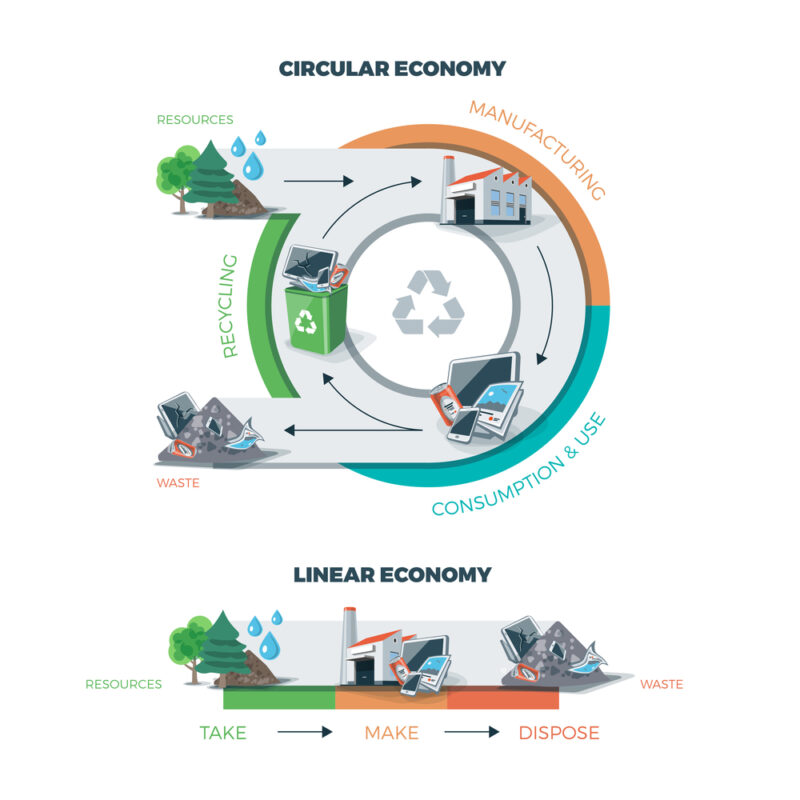27 E-Waste Statistics: Electronic Waste Generation & Consequences in 2025
E-waste statistics paint a picture of how direly we need policies to regulate e-waste and its management. Countries like China are especially in a tough spot given the volume of e-waste they generate. In this article, we discuss some interesting e-waste statistics that shed more light on the problem.
Top E-Waste Facts & Statistics
- Over 53.6 million metric tons of e-waste were generated worldwide in 2019.1
- Countries like China, the U.S. and India are producing massive amounts of e-waste. China alone produced 10,129 kt of e-waste in 2019.1
- Over 80% of e-waste was unaccounted for in 2019, and a significant volume of e-waste is exported illegally every year.1

E-waste is creating some major problems for our planet. To give you a preview, we’ve compiled 27 interesting e-waste statistics. If you’ve ever wondered about the volume of e-waste generated, the toxic materials e-waste contains and how the world’s e-waste problem is growing quickly, the shocking e-waste statistics in this article are for you.
Electronic devices have transformed the way humans live and interact with people and their environment. The new generation can’t imagine living in a world devoid of gadgets. What many don’t see is the consequence this consistent increase in the use of electronic items has on the environment and society as a whole and that’s what these statistics reveal.
Electronic Waste: What Is E-Waste?
E-waste (or electronic waste) includes any discarded electronic device or component, such as microwaves, mobile phones and motherboards.

1. The Types of E-Waste
Here are six categories of e-waste:
- Lamps
- Small IT and telecom equipment
- Screens and monitors
- Temperature exchange equipment
- Large equipment
- Small equipment
2. E-Waste Chemicals
These discarded electronic items end up in the garbage. When they’re buried, they leach toxic chemicals that are harmful to the environment and the health of humans and wildlife.
As you can imagine, growing volumes of e-waste can spell disaster for our planet. Earth is accumulating several million tons of e-waste each year. With that in mind, let’s talk about some key statistics about e-waste.
E-Waste Generation Around the World
Here are some key statistics related to e-waste generation around the world.
3. How Much E-Waste Is Generated Each Year?
Over 53.6 million metric tons of e-waste is generated worldwide each year, according to the Global E-waste Monitor’s 2020 report.1 To put that into perspective, that’s around 7.3 kg of waste per person.
4. Which Countries Produce the Most E-Waste?
China leads the charge and generates over 10,129 kt of e-waste according to research data from 2019.1 It’s followed by the U.S. and India, which contribute 6,918 kt and 3,230 kt of e-waste, respectively.
5. Which Regions Produce the Most E-Waste?
Asia produces the most e-waste, followed by Europe and North America.3 However, Europe produces the most e-waste per capita, with each citizen responsible for generating 16 kg.
Percentage of Total E-Waste By Region
6. Customer Behavior With Old Devices
An 2021 analysis showed that 49.1% (the majority of the survey participants) didn’t recycle their old devices due to a lack of knowledge.4 Among them, 43% admitted that they store their old devices at home while 23.7% of respondents generally give them away to their relatives or friends.
7. Most Common Types of E-Waste
Out of the 53.6 Mt of total e-waste, small equipment like microwaves, kettles, fans, vacuum cleaners, toasters and hair dryers amount to 17.4 Mt of e-waste.1 In comparison, large equipment like washing machines and dishwashers amount to 13.1 Mt of e-waste.
E-Waste By Category (Mt)
Temperature-adaptable devices (like refrigerators and air conditioners) account for 10.8 Mt, devices with screens (like televisions) and minor IT and telecom equipment (like phones, e-readers and keyboards) contribute to 6.7Mt and 4.7Mt, respectively. Lamps and bulbs are responsible for the remaining 0.9 Mt.2
8. How Often We Replace Certain Devices
Although 71% of Americans try to use their current electronic devices as long as possible, 15% buy new ones as soon as they can.6 For the remaining 13%, it depends on the circumstances and preferences at any given point. However, age and income play an essential role in this decision.
Almost 20% of respondents to another survey said they replace their smartphones once a year.7
9. Overlooked Device Recycling Opportunities
Most countries are likely overlooking the potential of old devices. For instance, only 1% of the produced cell phones are recycled.17 This reflects a major problem, as mobile phones rank fourth among the most hoarded electrical and electronic equipment by consumers globally.18

E-Waste Management: How Electronic Waste Is Handled
Governments have come up with various ways to handle electronic waste. For example, many countries recycle much of the e-waste they generate. Below are critical statistics on how e-waste is managed around the world.

10. Worldwide E-Waste Recycling Statistics
According to a 2020 report, only 17.4% of e-waste is documented to be adequately recycled worldwide.1 This means only 9.3 million metric tons of the total e-waste is accounted for and recycled.
No one knows what happens to nearly $47.6 billion worth of recyclable materials, such as iron, copper, gold and other recoverable goods. They may be dumped, burned or recycled in an undocumented way.8
11. E-Waste Landfill and Incineration Statistics
Almost 8% of generated e-waste ends up in regular waste bins in high-income countries, according to a 2020 report.1 They’re subsequently dumped in landfills and burned in incinerators. Generally, small equipment and IT devices are discarded in this way.
12. E-Waste Statistics Regarding Legal Exportation
Out of the total e-waste generated globally, just 1.8 million metric tons is exported according to the Basel Convention control regime and marked as hazardous waste.10 This allows for the recycling of nearly $9.4 billion worth of raw materials, including iron, gold, copper and other valuable items.
However, 3.3 Mt, or 65%, of transboundary movements are uncontrolled EEE, or e-waste. In many cases, EEE is mixed with other legal shipments as cover, but perpetrators may use a combination of licit and illicit methods.10
13. Illegal Exportation and Dumping of E-Waste
Since nearly 44.3 Mt of e-waste — nearly 82.6% of the total — is unaccounted for, much of this waste is exported illegally in the name of scrap or reusable material.1
Global E-Waste By Disposal (Mt)
Illegal exportation of e-waste is increasing, as it’s cheaper to export it to the developed markets known for treating raw materials than treating them domestically. The site of electrical and electronic equipment production plays a big role, too.10
13. Illegal Trade Seizure of E-Waste
According to a 2022 report, only 2 kt to 17 kt of waste was seized out of the millions of tons of e-waste illegally traded from the E.U.10 Traders mix illegal e-waste with legal shipments during cross-border movement to thwart officials. Incorrect clarification and misreporting are some other challenges.
The Effects of E-Waste: Toxins & Human Health
E-waste that’s burned in incinerators releases toxic fumes, which are harmful to human health and can have serious consequences like cardiovascular complications. Moreover, direct contact with toxic e-waste is detrimental to humans. Over-exposure could even damage DNA, thyroid function and lung function, according to the WHO.11

14. E-Waste Statistics Regarding Human Health
In workers’ quest to recover valuable materials like gold and copper from e-waste, they are subjected to over 1,000 damaging substances, including mercury, lead, brominated flame retardants, nickel and polycyclic aromatic hydrocarbons (PAHs), according to the WHO.11
15. Women Employed in the Informal E-Waste Sector
To keep up with the disposal volumes of e-waste, nearly 12.9 million women are employed in the informal e-waste sector according to the World Health Organization (WHO).11 This subjects them to toxic e-waste exposure and is especially harmful to pregnant women.
For instance, it could cause reduced neonatal behavior neurological assessment scores and promote attention-deficit or hyperactivity disorders (ADHD). Moreover, it can result in changes in child temperament, sensory integration difficulties and lower cognitive and language scores. It could even lead to still or premature births.11
16. Children Employed in the Informal E-Waste Sector
More than 18 million children and adolescents are asked by their parents or caregivers to participate in e-waste recycling since their small hands are more nimble than those of adults. This exposure to e-waste is more dangerous for them as they absorb more given their size, less developed organs and reduced ability to metabolize.11
For children, regular exposure to e-waste could cause damage to DNA, lead to chronic diseases like cancer over time and affect lung and respiratory function.
17. E-Waste Hazardous Mercury and BFR
Nearly 50 tons of mercury and 71,000 tons of brominated flame retardant (BFR) plastics are found in unreported e-waste movement across borders. If released, the high volume of mercury would be harmful to humans and the environment at large, according to a 2020 report.1
18. Electronic Waste CO2 and Refrigeration Pollution
Irresponsible incineration of e-waste releases toxic fumes into the air, positively contributing to global warming. For instance, in 2019, 98 million metric tons of CO2-equivalents were added to the atmosphere just from refrigerators and air conditioners that ended up in the trash.12
Toxins released from e-waste negatively impact air quality and lead to long-term health problems like respiratory issues, back ailments and skin sores.12
19. Toxins Affecting Livestock
Livestock aren’t exempt, either, especially in developing countries. Adult chicken eggs in Agbogbloshie — the largest food market in Accra, Ghana — could contain up to 220 times more toxins than the safety limits and their consumption could lead to cancer, reproductive issues and hormonal imbalances.12
20. Lead Exposure From E-Waste
Lead released during incineration in municipal waste facilities or informal recycling centers can travel long distances and settle into the soil before contaminating groundwater. This exposure can adversely affect the human nervous system, harm the brain and kidneys and in extreme cases cause death.13
21. Other Harmful Chemical Toxins From E-Waste
Lead isn’t the only toxin released in the environment. In 2015, e-waste processing was responsible for the generation of other heavy metals, including 36,000 tons of cadmium, 13.6 tons of mercury and 198,000 tons of chromium. Exposure to any one or more of these toxins can cause irreparable damage to both humans and the environment.13
Similarly, exposure to and inhalation of toxic fumes generated during e-waste recycling from arsenic and polybrominated diphenyl ethers (PBDEs), dioxins (PCDDs) and furans (PCDFs) can be equally dangerous.13
22. E-Waste Recycling Missed Opportunities
Recycling e-waste can help recover precious metals. For instance, recycling 1 million mobile phones would help recover 35,000 pounds of copper, 75 pounds of gold, 772 pounds of silver and 33 pounds of palladium.14 Alternatively, recycling 1 million laptops could save the electrical energy consumed by almost 3,500 American households in a year.
23. Lost Gold in Failing to Recycle Electronic Waste
E-waste is a literal goldmine. If we could recover all the gold in the current e-waste, it would add up to nearly 11% of the gold mined in a year globally.15
The Future of E-Waste
While the general public is expected to become more cognizant of the issue and take steps to manage e-waste, new production, inappropriate dumping, inaccurate documentation and illegal trade will continue to create challenges.
24. E-Waste Statistics Regarding Predictions
The StEP initiative predicts that global e-waste generation will grow to 75 million tons by 2030 and 111 million tonnes by 2050.16
25. E-Waste Can Match the Demand and Reduce the Scarcity of Rare Metals
Rare metals are high in demand. However, their scarcity and monopolization by China are driving up the costs for manufacturers. Since China produces 97% of the world’s rare metals, countries like the U.S., Russia, India, Brazil and Australia are trying to find sources of their own.17
26. New Production Contributing to E-Waste
With 25-50 billion devices in use, the growth and development of the electronics sector will encourage the manufacturing industry to produce more devices every year, with e-waste becoming the fastest-growing waste segment in the world.19
27. Circular Economies
Some regions, including Europe, are encouraging that consideration of “circular economy” principles — where devices are designed to have reusable components — to help reduce the amount of e-waste.2

Methodology and Further Information
We’ve searched high and low to get these pressing e-waste statistics for you. We listed our sources at the end of the article. Please feel free to use this information per your needs, but please credit this article.
Final Thoughts: E-Waste Disposal
The e-waste problem is only getting bigger each year. Governments, especially in countries that produce large volumes of e-waste, need a robust framework to mitigate the ill effects of e-waste on the environment. In the future, we’re likely to see more e-waste policies across industries.
What do you think of e-waste? How do you dispose of your discarded electronics? Do you use an e-waste recycling company? How should countries address e-waste materials? Let us know in the comments. Thank you for reading.
If you liked this statistics article, check out some of our other articles:
- Online Shopping Statistics
- Cloud Computing Statistics
- Online Dating Statistics
- Social Media Addiction Statistics
- Metaverse Statistics
Sources:
- The Global E-waste Monitor 2020 — United Nations Institute for Training and Research
- Circular Economy — European Commission
- Electronic Waste Facts — The World Counts
- Analysis of Households’ E-Waste Awareness, Disposal Behavior and Estimation of Potential Waste Mobile Phones in Dubai — Heriot-Watt University
- How Often Do We Upgrade Our E-Devices? — ERI
- Most Americans Try To Hold Onto Their Electronic Devices as Long as They Can — CBS News
- How Often Do Users Purchase a New Mobile Phone? — Nevis Software
- Global E-Waste Flows Monitor 2022 | Waste Management World
- Surge in Global E-Waste, up 21% in 5 Years — The Global E-Waste Statistics Partnership
- Global Transboundary E-waste Flows Monitor 2022 — United Nations Institute for Training and Research
- Soaring E-Waste Affects the Health of Millions of Children — World Health Organization
- How Our Old Computers, TVs and Other Electronics Are Making Children Sick — Geneva Solutions
- Toxins in WEEE (E-Waste) – University of Washington
- Electronics Donation and Recycling — US EPA
- Electronic Waste Is a First-World Problem, Which Asia Will Have To Deal With Soon — e27
- Future E-Waste Scenarios — United Nations Environment Programme
- Where to Find Rare Earth Elements — PBS NOVA
- International E-Waste Day — WEEE Forum
- Tapping the Economic Value of E-Waste — China Daily


